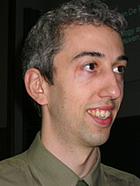 Dr. Jan De RijckThe astounding success of the cocktails of anti-HIV medications known as highly active antiretroviral therapy (HAART), which have dramatically increased the life expectancy of people with HIV/AIDS, is undeniable. Our ability to control the growth of HIV and its attack on immune cells, potentially for the lifetime of an infected individual, is based on our having a large repertoire of molecules belonging to different drug classes. These include the familiar reverse transcriptase and protease inhibitors, as well as the newer integrase inhibitors, all acting against key HIV enzymes.
Dr. Jan De RijckThe astounding success of the cocktails of anti-HIV medications known as highly active antiretroviral therapy (HAART), which have dramatically increased the life expectancy of people with HIV/AIDS, is undeniable. Our ability to control the growth of HIV and its attack on immune cells, potentially for the lifetime of an infected individual, is based on our having a large repertoire of molecules belonging to different drug classes. These include the familiar reverse transcriptase and protease inhibitors, as well as the newer integrase inhibitors, all acting against key HIV enzymes.
Now Dr. Jan De Rijck, recipient of an amfAR Mathilde Krim Fellowship, and
colleagues in Belgium report on a potential new target. Rather than focusing on
HIV integrase itself, it involves proteins in the normal cell, which are
required for the activity of that viral enzyme. Unlike a virus protein, a host
protein is much less likely to become resistant to drug attack through
selecting out mutant forms, as often occurs using medications that attack HIV
directly.
The virus has a back-up plan.Writing in the October 2012 issue of the
journal Retrovirology, De Rijck and
associates describe work with LEDGF (lens epithelium-derived growth factor), a
normal cellular protein they had discovered previously. It is required to bind,
or tether, the DNA form of HIV and its integrase to host cell DNA. This
accomplishes two things. It permits entry of HIV into the genetic material of a
cell, establishing a latent infection. And it determines the specific regions
of the host cell’s genetic material where HIV will become incorporated.
In these new studies, Dr. De Rijck notes that removing LEDGF
from a cell does not completely stop the virus from integrating. The virus has
a back-up plan, involving another normal host protein, HRP-2. Normal levels of
HRP-2 may not permit a robust infection in the absence of LEDGF, but it’s good
enough to enable random integration of HIV DNA, and cause cell damage.
These new studies point the way to development of drugs that
might interfere with both of these processes.
Dr.
Laurence is amfAR’s senior scientific consultant.